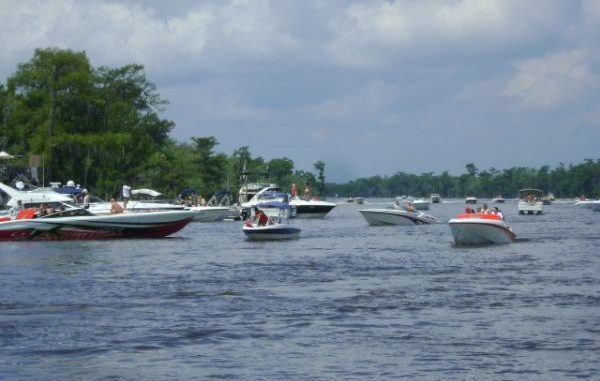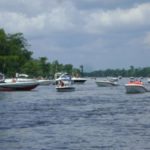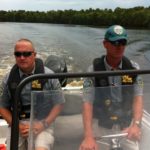
Great info for staying safe on the water this summer
Louisiana summer boating activity peeks in June. Considering how much boating takes place on any given day of any other month in the Sportsman’s Paradise, it’s safe to say things can get pretty hectic on a sunny weekend in June.
A wildlife enforcement agent’s summer workday will be dedicated almost entirely to boating safety — day after day, week after week.
Wildlife agents receive a great deal of training in everything associated with boating, and I would not hesitate to say that the best “boat cops” in the country are found along the Gulf Coast and in the Southeastern states. They are not only well trained, but with time on the job comes a wealth of experience related to boating safety, search and rescue, and accident investigation.
An experienced agent will often spot trouble before it ever happens. Many times, intervention or assistance will prevent accidents and injuries, and recognizing the warning signs is an essential acquired skill.
I did my share of water patrol and accident investigation while on the job, and shared the experiences of many other agents through casual discussions and reviewing accident reports.
It did not take long to learn that every good water-patrol agent watches for the same things. Let’s look at some signs of potential trouble wildlife agents see on the water. By learning to recognize those signs, anyone can become a safer boat operator and avoid serious problems.
Shoddy equipment means trouble. This does not necessarily mean old equipment. Plenty of old but well-maintained boats and engines provide safe and reliable platforms for recreational boating, and poor maintenance can cause even new equipment to fail.
Cracked or dry-rotted fuel lines, fouled spark plugs, contaminated fuel or clogged fuel filters will cause engine failure and fire hazards.
Speaking of which, a fire on board is bad — really bad if the fire extinguisher is old and dead.
A leaking hull or rotted transom can lead to sinking or, worse yet, structural collapse, usually while the engine is running wide open.
Poorly fitting or worn-out drain plugs have caused more than one boater to become a swimmer.
So check the hull and transom from time to time. Look for stress cracks, pitting and dents or holes.
Weak batteries, fried wiring, blown fuses and burned-out lights are common problems for those who don’t inspect, replace and repair such things.
Even more dangerous are cable-and-pulley steering systems. Thank goodness we don’t see many of those anymore, but I have seen frayed cables and rusted pulleys ready to break at any moment.
Loss of steering control usually causes the operator and passengers to be ejected into the water, where they are then killed or maimed by the out-of-control boat.
Get rid of old or outgrown personal flotation devices. Tug on those straps and buckles, and check the flotation containment compartments for rot. If it fails, discard the PFD and get a new one.
Or you can wait and let the patrol agent do it during his inspection. Just remember that if the strap breaks when he tugs, the result is a citation and terminated trip with free escort to the landing.
Deteriorating weather or an approaching storm are sure signs of trouble ignored by many boaters. For whatever reason, Toledo Bend Reservoir is a prime location for sinking and capsizing accidents during high winds. Maybe it’s the large expanse of open water combined with the vast stump fields, or maybe the geographic area gets higher wind gusts for unknown reasons. But agents who patrol this huge reservoir are frequently called upon to rescue boaters who did not heed rising winds or an approaching storm in time to get off the water.
Even if wind is not a factor, lightning can be deadly. Check the weather forecast for the possibility of thunderstorms, and if lightning is seen or thunder is heard in the distance, head for shore. Don’t wait, and don’t hesitate.
Should you ever get caught in a lightning storm on the water and manage to survive, you won’t let it happen again.
Failure to keep track of time can lead to trouble. Sunset on the water is a very pleasant time of day. The temperatures cool and things quiet down when most of the other boaters have gone in.
But darkness comes a half hour after sunset and, for someone unfamiliar with his or her surroundings, everything looks different.
And if the boat is not equipped with searchlights in addition to running lights and some type of navigational aid, the operator can become completely disoriented.
I recall one such search and rescue. Two young men were fishing and stayed until dark. They then began trying to find their way back to the boat landing. But the bayous and bays were now very confusing.
They soon became lost and ran out of fuel. We found them around midnight. They at least had a searchlight and used it to signal us. Their adventure taught them some valuable lessons.
Alcohol consumption and substance abuse are other signs of potential trouble. It is very easy to get caught up in the fun and have a few or even several too many.
Few people realize how wind, sun and heat intensify the effects of alcohol.
Obviously the boat operator should never drink or use drugs but passengers need to limit consumption, too. A completely sober operator has enough to worry about while driving the boat without the distraction of drunk and unruly passengers.
Victims in a number of boat accidents have been killed or injured because they were under the influence. They either fell overboard or caused a collision by distracting the operator.
These are just a few simple things everyone can do to avoid problems and hazards on the water. Boat safe, boat sober and enjoy our great abundance of boating opportunities.




